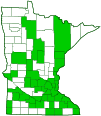honey locust
(Gleditsia triacanthos)
Conservation • Wetland • Description • Habitat • Ecology • Use • Distribution • Taxonomy
Description |
||
Honey locust is a fast-growing, moderately long-lived, deciduous tree rising on a single trunk from a strong taproot and a deep, profusely-branched, wide-spreading root system. Unlike most trees, this species has root hairs. In Minnesota, mature trees are usually 40′ to 60′ tall and up to 18″ in diameter at breast height, though large individuals can reach over 80′ in height and 36 ″ in diameter. A thornless form (f. inermis) is widely cultivated but occurs only sporadically in nature. The trunk is short and is often divided in the lower half of the tree’s total height. The trunk and major branches are armed with long, conspicuous thorns, often in clusters. The thorns are deep brown, stout, slightly flat, ¾″ to 8″ long, and often branched (compound). The crown is broad, open, and often flat-topped. The branches are slender and spreading or ascending. They are armed with thorns that are 1″ to 4″ long, 1 ⁄16″ to ⅛″ in diameter at the base, and often with many-branched. The bark on young trunks is reddish-brown and smooth with numerous dark, horizontal lines (lenticels). On mature trunks the bark is light gray to dark gray or nearly black, deeply furrowed, and broken into long, narrow, scaly plates. There are two kinds of shoots (young twigs): long, shoots with alternate leaves, and short shoots, barely clearing the bark, with clustered leaves. The long shoots are somewhat zigzag, green, and hairy at first, eventually becoming hairless, reddish-brown, and shiny. Twigs are may be either stout or slender. They are armed with smooth, reddish-brown, 1″ to 3″ long, often 2-branched, sometimes 3-branched, thorns. The thorns appear singly at the nodes. There is no terminal bud. Lateral buds are small and are hidden beneath the leaf scar, often appearing as small knobs. The leaf scars are U-shaped and have 3 bundle scars. Two types of leaves are produced: early leaves, also called preformed leaves; and late leaves, also called neoformed leaves. The leaf stalk (petiole) of both types of leaves is 4″ to 8″ long and distinctly short-hairy. The central axis (rachis) is light green and short-hairy. Early leaves are fully formed and overwinter in the bud. They are the first leaves to mature in the spring. They are produced on short, preformed shoots and at the base of long, partially preformed, partially neoformed shoots. They are 4¾″ to 5½″ long and singly, evenly, pinnately compound, divided into 7 to 16 pairs of leaflets with no terminal leaflet. The leaflets on these leaves are narrowly egg-shaped, ⅜″ to 1½″ long, and ¼″ to 9 ⁄16″ wide. They are on very short, about 1 ⁄32″ long stalks (petiolules). They are widest near the base, rounded or broadly angled at the base, and rounded at the tip. The upper surface is green or dark green and hairless. The lower surface is pale green and short-hairy at least along the midvein. The margins are very finely toothed. Late leaves are formed at the end of long shoots. They are twice evenly, pinnately compound, divided into 4 to 7 pairs of branches (pinnae). Each pinna has 5 to 10 pairs of leaflets and resembles a once pinnate leaf. The leaflets on these leaves are somewhat smaller, narrowly egg-shaped to egg-shaped, ½″ to 1″ long, and ¼″ to ½″ wide. They otherwise resemble leaflets on singly compound leaves. Male and female flowers are borne on the same plant, usually in separate inflorescences and often on separate branches, though some inflorescences have both male and female flowers. The inflorescences appear in the leaf axils of short shoots in late May to late June with the leaves. Each inflorescence is a 2″ to 3½″ long, spike-like, branched cluster (raceme). The female inflorescence has fewer, more widely spaced flowers than the male. The flowers are small and inconspicuous. They have 3 to 5 sepals and 3 to 5 petals. The sepals are 1 ⁄16″ to ⅛″ long and are similar in color to the petals. The petals are about 1 ⁄16″ long and yellowish green. Male flowers have 5 to 8 stamens with 1 ⁄16″ to ⅛″ long filaments. The female flower has a short style with with a 2-lobed stigma. The flowers are fragrant. The fruit is a 7″ to 16″ long, 1″ to 1½″ wide, strongly flattened, usually spirally twisted pod with many seeds. The pod is green at first, and the seeds are embedded in a thick, sweet, jelly-like pulp. They eventually turn purplish-brown and the pulp becomes dry and inconspicuous. The fruit ripens in late August to late September and remains on the tree through the winter. The seeds are dispersed by animals. |
||
Height |
||
40′ to 80′ |
||
Record |
||
The champion honey locust in Minnesota is on public property near Fairmont, in Martin County. In 1999 it was measured at 80′ tall and 168″ in circumference (53½″ in diameter), with a crown spread of 83′. |
||
Flower Color |
||
Yellowish-green |
||
Similar Species |
||
Black locust (Robinia pseudoacacia) has a pair of short spines at the base of each leaf but is otherwise thornless. The leaflets are much larger, ¾″ to 2⅜″ long, and ⅜″ to 1 3 ⁄16″ wide. The inflorescence has large, showy, white, pea-like flowers. The fruit is much smaller, no more than 4″ long and ⅝″ wide. Kentucky coffee tree (Gymnocladus dioica) has no thorns. The leaflets are much larger, 1½″ to 3½″ long, and ¾″ to 1 3 ⁄16″ wide. The fruit is much smaller, no more than 6″ long, and is thick, not strongly flattened. |
||
Habitat |
||
Moist. Shade intolerant. Bottomlands, parks, and old homesteads. |
||
Ecology |
||
Flowering |
||
Late May to late June |
||
Pests and Diseases |
||
|
||
Use |
||
|
||
Distribution |
||||
|
Sources |
|||
| 5/1/2023 | ||||
Nativity |
||||
Native |
||||
Occurrence |
||||
Rare and scattered. Native probably extirpated. There may be no native honey locust trees left in the state. The last known naturally occurring tree was submerged behind lock and dam number 8 on the 1930s. Mosty existing specimens are likely cultivars planted in parks or near homes following European settlement in the last half of the 19th century. Cultivars currently popular with landscapers have no thorns and produce no fruit. The single tree in Vermillion Highlands Research Recreation and WMA does have thorns on the branches and on the trunk. |
||||
Taxonomy |
|||
| Kingdom | Plantae (Plants) | ||
| Subkingdom | Pteridobiotina | ||
| Phylum | Tracheophyta (Vascular Plants) | ||
| Class | Magnoliopsida (Dicots) | ||
Order |
Fabales (Legumes, Milkworts, and Allies) | ||
Family |
Fabaceae (Legumes) | ||
| Subfamily | Caesalpinioideae (peacock flower) | ||
| Tribe | Caesalpinieae | ||
| Genus | Gleditsia (honey locusts) | ||
Subordinate Taxa |
|||
Two forms are recognized. The nominate form, Gleditsia triacanthos f. triacanthos, has long thorns on the branches and on the trunk. A cultivated form, Gleditsia triacanthos f. inermis, has no thorns. |
|||
Synonyms |
|||
| Gleditsia triacanthus var. inermis | |||
Common Names |
|||
common honeylocust honey-locust honey locust honeylocust |
|||
Glossary
Axil
The upper angle where a branch, stem, leaf stalk, or vein diverges.
Bundle scar
Tiny raised area within a leaf scar, formed from the broken end of a vascular bundle.
Compound leaf
A leaf that is divided into leaflets, each leaflet having the general appearance of a leaf, with all leaflets attached to a single leaf stem.
Filament
On plants: The thread-like stalk of a stamen which supports the anther. On Lepidoptera: One of a pair of long, thin, fleshy extensions extending from the thorax, and sometimes also from the abdomen, of a caterpillar.
Lenticel
A corky, round or stripe-like, usually raised, pore-like opening in bark that allows for gas exchange.
Node
The small swelling of the stem from which one or more leaves, branches, or buds originate.
Petiole
On plants: The stalk of a leaf blade or a compound leaf that attaches it to the stem. On ants and wasps: The constricted first one or two segments of the rear part of the body.
Petiolule
The stalk of a leaflet blade on a compound leaf.
Pinna
The primary division of a compound leaf or fern frond.
Pinnate
On a compound leaf, having the leaflets arranged on opposite sides of a common stalk. On a bryophyte, having branches evenly arranged on opposite sides of a stem.
Raceme
An unbranched, elongated inflorescence with stalked flowers. The flowers mature from the bottom up.
Rachis
The main axis of a compound leaf, appearing as an extension of the leaf stalk; the main axis of an inflorescence.
Sepal
An outer floral leaf, usually green but sometimes colored, at the base of a flower.
Stigma
In plants, the portion of the female part of the flower that is receptive to pollen. In Odonata and Hymenoptera, a blood-filled blister or dark spot at the leading edge of each wing toward the tip, thought to dampen wing vibrations and signal mates. In Lepidoptera, an area of specialized scent scales on the forewing of some skippers, hairstreaks, and moths.
Visitor Photos |
|||||
Share your photo of this plant. |
|||||
| This button not working for you? Simply email us at info@MinnesotaSeasons.com. Attach one or more photos and, if you like, a caption. |
|||||
Carolyn |
|||||
Just noticed this week, the seed pods all came off this huge old tree. It is located in the back yard of a neighbor, at the intersection of 15th ave n, and 3rd ave. in St. Cloud. |
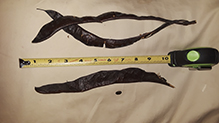 |
||||
Randy |
|||||
Honey locust bearing fruit |
|||||
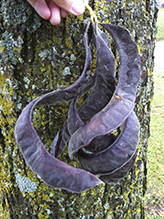 |
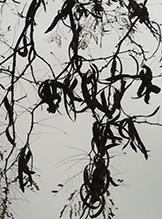 |
||||
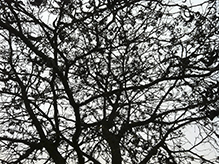 |
|||||
Thorns on a honey locust |
|||||
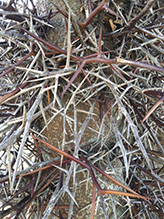 |
|||||
MinnesotaSeasons.com Photos |
|||||
Tree |
|||||
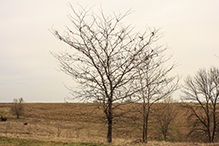 |
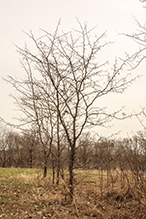 |
||||
Thorns |
|||||
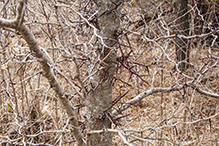 |
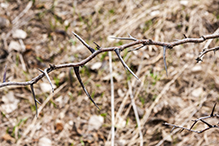 |
||||
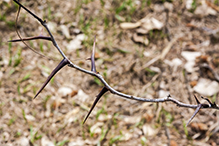 |
|||||
Fruit |
|||||
 |
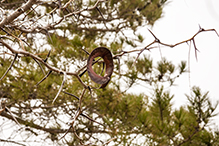 |
||||

Slideshows |
||
| Gleditsia tricanthos Blake C. Willson |
||

|
||
About
Thornless Honey Locust |
||
| Gleditsia triacanthos - Honey Locust Virens (Latin for greening) |
||
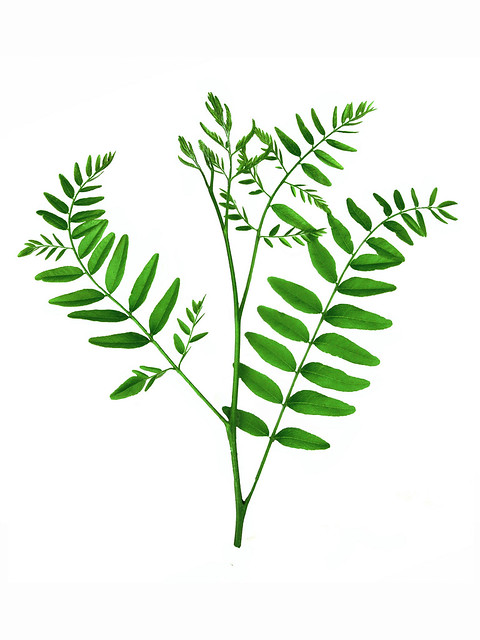
|
||
About
Leguminosae - Pea Family also Fabaceae - Bean Family A favorite New York City street tree native to North America. Plant profile: plants.usda.gov/java/profile?symbol=GLTR |
||

Visitor Videos |
|||
Share your video of this plant. |
|||
| This button not working for you? Simply email us at info@MinnesotaSeasons.com. Attach a video, a YouTube link, or a cloud storage link. |
|||
Other Videos |
|||
| Honey Locust from Blossom to Pod--unlocking the food zuditaka |
|||
About
Uploaded on Dec 25, 2010 Here I am, observing the growth of honey locust beans--from blossom to pod. The flowers bloom in spring, and have rather a ginger-like spicy scent--attracting vuvuzelas of bees. With good spring and summer rain, they have, now, turned quickly into long juicy pods. Won't be long before they are ready to harvest. However, this time I won't let them go all hard and unappetising--like tough old cardboard. I shall, instead, eat the honey-sweet pulp when the pods are still greenish and juicy. The botanical Latin for Honey Locust is Gleditsia triacanthos. They are a very useful permaculture species--to 50 metres high--from North America. Deciduous trees, and extremely drought-resistant--once established. If the streets and highways were planted out with this species, foragers and wayfarers would be provided with the beneficial free food. No-one would ever have to go hungry--at least not at Honey Locust podding time. But, sadly, that isn't how things are done! |
|||
| Honey Locust Tree aka Thorny Locust Wise Snake |
|||
About
Published on Jul 30, 2013 The Honey locust, Gleditsia triacanthos, also known as the thorny locust, is a deciduous tree native to central North America. It is mostly found in the moist soil of river valleys ranging from southeastern South Dakota to New Orleans and central Texas, and as far east as eastern Massachusetts. Honey locusts commonly have thorns 3--10 cm long growing out of the branches, some reaching lengths over 20 cm; these may be single, or branched into several points, and commonly form dense clusters. The thorns are fairly soft and green when young, harden and turn red as they age, then fade to ash grey and turn brittle when mature. These thorns are thought to have evolved to protect the trees from browsing Pleistocene megafauna which may also have been involved in seed dispersal, but the size and spacing of them is useless in defending against smaller extant herbivores such as deer. Despite its name, the honey locust is not a significant honey plant. The name derives from the sweet taste of the legume pulp, which was used for food by Native American people, and can also be fermented to make beer. The long pods, which eventually dry and ripen to brown or maroon, are surrounded in a tough, leathery skin that adheres very strongly to the pulp within. The tree has been used in traditional Native American medicine. Extracts of Gleditsia possess important pharmacological activities in treating rheumatoid arthritis, as anti-mutagenic, anticancer and have significant cytotoxic activity against different cell lines. Seeds of Gleditsia triacanthos contain a trypsin inhibitor. |
|||
| Honey Locust, Gleditsia tricanthos, the real thing. Delticola |
|||
About
Published on Jun 9, 2012 What we have here is the real thing, a honey locust tree. Full of thorns and seed pods. The seed pods are fully edible by both human and other animals. This specimen is not in the natural range, it is growing in Decatur, Georgia outside of Atlanta. |
|||
| Comparing toxic Black Locust pod and an edible Honey Locust pod zuditaka |
|||
About
Uploaded on Nov 21, 2011 Many people on YouTube, including some nursery owners (who should know better!), cannot tell the difference between a toxic Black Locust pod and an edible Honey Locust pod. Just a quick look, in the garden, today, at the difference between Black Locust pods and Honey Locust pods. You can see that the Black Locust pods are only tiny in comparison to the giant (brown-coloured) Honey Locust pods. There is also a leaf difference, too. The Gleditsias have smaller leaves and the Robineas have larger leaves. Disclaimer: |
|||
| Trees with Don Leopold - honeylocust ESFTV |
|||
About
Published on Jun 12, 2012 No description available. |
|||

Visitor Sightings |
|||||
Report a sighting of this plant. |
|||||
| This button not working for you? Simply email us at info@MinnesotaSeasons.com. Be sure to include a location. |
|||||
| Stujacobson 10/21/2023 |
Location: River Edge, NJ |
||||
| Carolyn 3/18/2020 |
Location: St. Cloud, MN Just noticed this week, the seed pods all came off this huge old tree. It is located in the back yard of a neighbor, at the intersection of 15th ave n, and 3rd ave. in St. Cloud. |
 |
|||
| Karen Kormann June, 2017 |
Location: Midway area, St Paul, near Hamline U Huge tree. I gather the dried fruit each fall. there are several smaller ones nearby. |
||||
| Randy October, 2016 |
Location: Albert Lea, MN Honey locust bearing fruit |
 |
|||
| Randy 7/19/2016 |
Location: near MN/IA border Thorns on a honey locust near MN/IA border |
 |
|||
| Loni Mentone 6/27/2016 |
Location: Saint Paul, 55116 This tree is growing in our back yard. We didn't know what it was until today. |
||||
MinnesotaSeasons.com Sightings |
|||||

|
Created: Last Updated: © MinnesotaSeasons.com. All rights reserved. |
